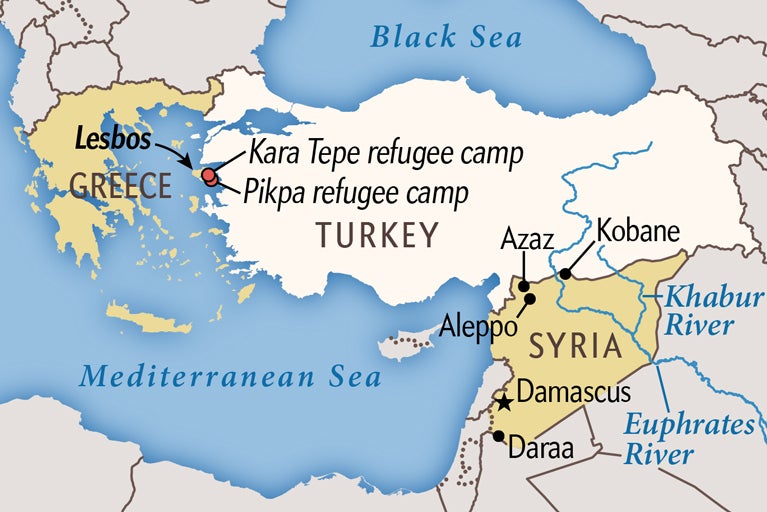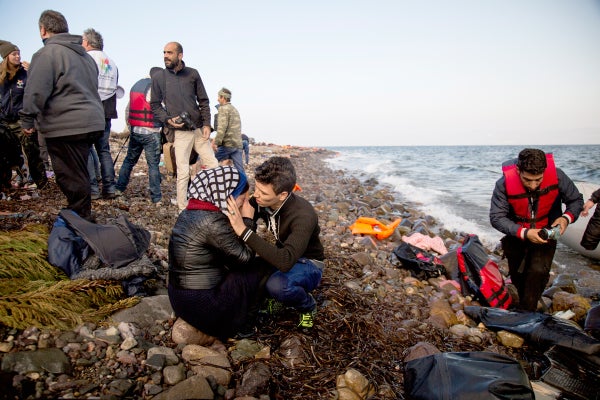Kemal Ali ran a successful well-digging business for farmers in northern Syria for 30 years. He had everything he needed for the job: a heavy driver to pound pipe into the ground, a battered but reliable truck to carry his machinery, a willing crew of young men to do the grunt work. More than that, he had a sharp sense of where to dig, as well as trusted contacts in local government on whom he could count to look the other way if he bent the rules. Then things changed. In the winter of 2006–2007, the water table began sinking like never before.
Ali had a problem. “Before the drought I would have to dig 60 or 70 meters to find water,” he recalls. “Then I had to dig 100 to 200 meters. Then, when the drought hit very strongly, I had to dig 500 meters. The deepest I ever had to dig was 700 meters. The water kept dropping and dropping.” From that winter through 2010, Syria suffered its most devastating drought on record. Ali's business disappeared. He tried to find work but could not. Social uprisings in the country began to escalate. He was almost killed by cross fire. Now Ali sits in a wheelchair at a camp for wounded and ill refugees on the Greek island of Lesbos.

Kemal Ali, 54 and injured, rests at the Pikpa refugee camp in Lesbos. He lived outside the destroyed city of Kobani in Syria and dug wells for farmers until the water disappeared because of drought and overuse. Photograph by John Wendle
On supporting science journalism
If you're enjoying this article, consider supporting our award-winning journalism by subscribing. By purchasing a subscription you are helping to ensure the future of impactful stories about the discoveries and ideas shaping our world today.
Climatologists say Syria is a grim preview of what could be in store for the larger Middle East, the Mediterranean and other parts of the world. The drought, they maintain, was exacerbated by climate change. The Fertile Crescent—the birthplace of agriculture some 12,000 years ago—is drying out. Syria's drought has destroyed crops, killed livestock and displaced as many as 1.5 million Syrian farmers. In the process, it touched off the social turmoil that burst into civil war, according to a study published in March in the Proceedings of the National Academy of Sciences USA. A dozen farmers and former business owners like Ali with whom I recently spoke at camps for Syrian refugees say that's exactly what happened.
The camp where I meet Ali in November, called Pikpa, is a gateway to Europe for asylum seekers who survive the perilous sea crossing from Turkey. He and his family, along with thousands of other fugitives from Syria's devastated farmlands, represent what threatens to become a worldwide crush of refugees from countries where unstable and repressive governments collapse under pressure from a toxic mix of climate change, unsustainable farming practices and water mismanagement.
40 years of fury
Syria's water crisis is largely of its own making. Back in the 1970s, the military regime led by President Hafez al-Assad launched an ill-conceived drive for agricultural self-sufficiency. No one seemed to consider whether Syria had sufficient groundwater and rainfall to raise those crops. Farmers made up for water shortages by drilling wells to tap the country's underground water reserves. When water tables retreated, people dug deeper. In 2005 the regime of Assad's son and successor, President Bashar al-Assad, made it illegal to dig new wells without a license issued personally, for a fee, by an official—but it was mostly ignored, out of necessity. “What's happening globally—and particularly in the Middle East—is that groundwater is going down at an alarming rate,” says Colin Kelley of the University of California, Santa Barbara, the PNAS study's lead author. “It's almost as if we're driving as fast as we can toward a cliff.”
Syria raced straight over that precipice. “The war and the drought, they are the same thing,” says Mustafa Abdul Hamid, a 30-year-old farmer from Azaz, near Aleppo. He talks with me on a warm afternoon at Kara Tepe, the main camp for Syrians on Lesbos. Next to an outdoor spigot, an olive tree is draped with drying baby clothes. Two boys run among the rows of tents and temporary shelters as they play a game of war, with sticks for imaginary guns. “The start of the revolution was water and land,” Hamid says.
Life was good before the drought, Hamid recalls. Back home in Syria, he and his family farmed three hectares of topsoil so rich it was the color of henna. They grew wheat, fava beans, tomatoes and potatoes. Hamid says he used to harvest three quarters of a metric ton of wheat per hectare in the years before the drought. Then the rains failed, and his yields plunged to barely half that amount. “All I needed was water,” he says. “And I didn't have water. So things got very bad. The government wouldn't allow us to drill for water. You'd go to prison.”
For a while, Ali was luckier than Hamid: he had connections. As long as he had a sack full of cash, he could go on digging with no interference. “If you bring the money, you get the permissions you need fast,” he explains. “If you don't have the money, you can wait three to five months. You have to have friends.” He manages a smile, weakened by his condition. His story raises another long-standing grievance that contributed to Syria's downfall: pervasive official corruption.
Syrians generally viewed thieving civil servants as an inevitable part of life. After more than four decades under the two Assad family totalitarian regimes, people were resigned to all kinds of hardship. But a critical mass was developing. In recent years Iraqi war refugees and displaced Syrian farmers have inundated Syria's cities, where the urban population ballooned from 8.9 million in 2002, just before the U.S. invasion of Iraq, to 13.8 million in 2010, toward the end of the drought. What it meant for the country as a whole was summarized in the PNAS study: “The rapidly growing urban peripheries of Syria, marked by illegal settlements, overcrowding, poor infrastructure, unemployment and crime, were neglected by the Assad government and became the heart of the developing unrest.”
By 2011 the water crisis had pushed those frustrations to the limit. “Farmers could survive one year, maybe two years, but after three years their resources were exhausted,” says Richard Seager, one of the PNAS study's co-authors and a professor at Columbia University's Lamont-Doherty Earth Observatory. “They had no ability to do anything other than leave their lands.”
Hamid agrees: “The drought lasted for years, and no one said anything against the government. Then, in 2011, we had had enough. There was a revolution.” That February the Arab Spring uprisings swept the Middle East. In Syria, protests grew, crackdowns escalated and the country erupted with 40 years of pent-up fury.

Slide Show: The Dangerous Passage of Syria's Climate Refugees. Photograph by John Wendle
No farming, no future
This year Hamid had to abandon his family's farm. The violence had become too much for him. “I left Syria because of the war and because there was no work,” he says.
Ali likewise tried to stick it out, but few of his former customers could afford to drill as deep as the water had sunk. And the war made ordinary activities practically impossible. His home village was only a short distance from the wreckage of Kobane on the Turkish border. That town was in ruins by the time the Kurds succeeded in recapturing it from ISIS, the militant group that has been terrorizing the region. Last July he headed for Syria's capital, Damascus, hoping to find work and a place where his family could be safe. He was on his way there by bus when a rocket struck the vehicle. He awoke in a Damascus hospital, paralyzed from the waist down. The blast had peppered his spine with shrapnel. Somehow his family managed to get him back north, and together they made their way across Turkey to the shores of the Aegean.

The Path to Deliverance: Most refugees who flee Syria cross into Turkey. From there, many make their way to the western coast, where they crowd onto large inflatable rafts for the 16-kilometer sea crossing to the Greek island of Lesbos. Map by Mapping Specialists
Desperate strangers of all ages gather along the Turkish coast every day, not only from Syria but from all over the Middle East. They crowd onboard big rafts and set out for the roughly 16-kilometer crossing to Lesbos. The boats are routinely overloaded, and in rough seas they are easily swamped. Most cannot swim, and 20 percent are children. Drownings happen all the time.
Many do reach Lesbos alive, and they move on as quickly as possible. On the island's northern beaches the first rays of sunrise illuminate discarded orange life vests and broken boats as far as the eye can see. Last November alone more than 100,000 foreign migrants passed through Greece, according to the International Organization for Migration. (A stunning 776,376 migrants had arrived in Greece since January 2015.) A bobbing orange dot on the horizon foretells the imminent arrival of yet another boat from Turkey. Nearing shore, one man stands up among the huddled passengers and raises his arms in triumph, flashing V-for-victory peace signs with both hands.
Louy al-Sharani, a 25-year-old from Damascus, splashes ashore with his older brother. They set off at a fast pace, carrying their bags up the steep coastal road. They both want to reach Norway as soon as possible. The brother is in a hurry to find work so he can bring his wife over before summer, when the couple's first child is due. Al-Sharani says he is eager to start earning his second master's degree. “I was born to use my mind,” he says. “I wasn't born to hold a machine gun and shoot people.”
“I was born to use my mind,” says a 25-year-old Syrian man after splashing ashore in Greece, hurrying up a steep dirt road. “I wasn’t born to hold a machine-gun and shoot people.”
Their mother sold all her jewelry, including her wedding ring, to give them $6,000 for the trip. They've already spent $2,400 to get this far, al-Sharani says. Still, what choice do they have? Before the war, Sharani earned a master's in agricultural economics, but now he sees no future in Syria for himself or for the country's farmers. As if the long-term drought wasn't bad enough, ISIS has made the country's prospects even more hopeless. He claims that warring factions are now stealing wheat reserves, in effect using food as a weapon to control populations. “A farmer today can't find water to irrigate, can't find government support, and always the rebels or the Syrian army is putting pressure on him. There are a million ways to die in Syria, and you can't imagine how ugly they are,” he says. “After 10 years, what I see, unfortunately, is a new Afghanistan.”
(In)Fertile Crescent
Columbia's Seager isn't quite so pessimistic. The refugee crisis will eventually subside, he assumes, and the war in Syria will run its course. Nevertheless, he says, the region's droughts will be more frequent and more severe for the foreseeable future. After closely studying dozens of climate models, he and Kelley and their colleagues are convinced that continued greenhouse gas emissions will widen the Hadley cell, the band of air that envelops the earth's tropics in a way that could further desiccate the lands of the eastern Mediterranean.

Syrian farmer Mustafa Abdul Hamid, 30, fled his country. “Now we are refugees from the war,” he says, “but before war, people were refugees from the villages, from the drought and from government policies.” Photograph by John Wendle
In fact, Seager says, the Fertile Crescent could lose its current shape and might cease to exist entirely by the end of this century because of severely curtailed water flow in the Euphrates and Jordan rivers. “There's not a lot of precipitation there, and when it does shift, it makes a difference,” he warns. “There's something specific about the Mediterranean that is making it hydrologically very sensitive to rising greenhouse gases.”
Having gotten out, Ali and his family are trying to somehow get him to Germany, where they hope surgeons will be able to restore his ability to walk. Outdoors in his chair to get a few minutes of sun, Ali is thinking of the friends he left behind in Syria. “The life of a farmer has always been hard,” he says. “Their biggest problem was water—period. Because water is life.”
His son wheels him indoors for a rest. Weak winter sunlight partially illuminates a big room lined with a couple of dozen beds. Plastic sacks and cheap duffle bags are heaped everywhere, holding their owners' few remaining possessions. As Ali's children lift him into bed, his face crumples in pain and exhaustion. Fardous, his 19-year-old daughter, tucks his colostomy bag against his body and arranges the donated blankets to cover him. “It is written in the Quran,” Ali repeats. “Water is life.”

